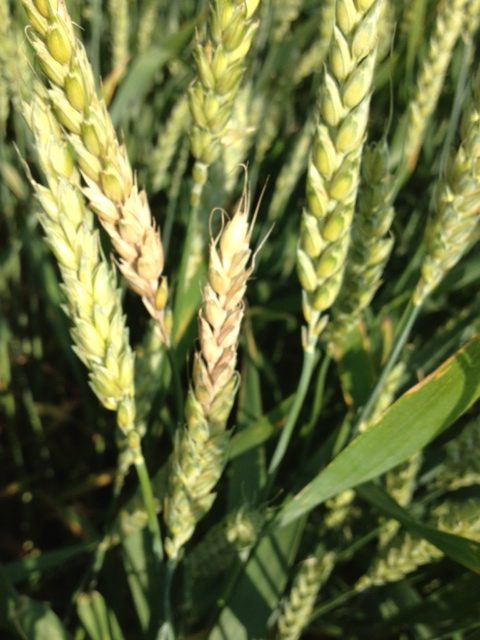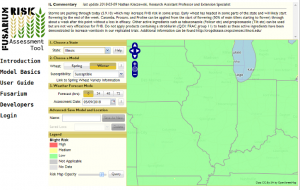Persistent humid weather and rains over the last 14 days has significantly elevated the risk of Fusarium head blight (FHB) in the south central portion of Illinois. Symptoms of FHB will start to develop around 18-24 days from the start of flowering, depending on temperatures and the variety (see figures below for examples). Understanding the field-level severity of FHB can be very useful in making harvest based management decisions.
Here are some general guidelines for assessing FHB in your wheat fields:
1) Try and assess the crop 18-24 days after the start of flowering (when 50% of main tillers start to flower) before plants have started to senesce. It is much easier to estimate FHB when heads are still green.
2) Take a paper bag and run a transect approximately 50 yards long through the field. Run one transect per 10 acres of field. Ensure that the transects are randomly selected but are representative of the field.
3) As you walk each transect, every so often pick a wheat head without looking down and place into your bag. Pick 10-20 heads per transect.
4) Once you have collected all the heads, take them back to your vehicle. Record the percent of the head with visual symptoms of FHB (bleaching, pink growth on spikelet).
5) After you have recorded all of your heads, take all the data from your heads and determine the percent FHB severity (sum of ratings of FHB for all heads including 0’s/total number of all heads collected).
Let’s illustrate on a small scale. You rate 10 wheat heads. The percentages of FHB for each of the 10 heads are: 0, 0, 1, 30, 20, 10, 30, 0, 0, 5, and 10. Add these up = 106
106 / 10 heads = 10.6% FHB severity
The greater the amount of FHB severity the more likely you may have elevated DON and issues with yields and test weights. A field level severity of 10% or more is where we typically start to see significant losses and problems related to FHB.
After rating your fields, you may have some that have elevated FHB and some that do not. This is where harvest-based management can help.
1) Research has shown that in cases where an FHB epidemic occur, changing your combine settings can result in an economic benefit to producers (click here for summery) . For example, in a study conducted by our colleagues at The Ohio State University, showed that, although some loss in yields occur when increasing combine fan speeds and increasing shutter openings to remove FHB-damaged grain, the improvement in grain quality and reduction in financial losses from price discounts (vomitoxin-DON, test weight, etc) can be great enough to compensate for the reduction in overall yields. The exact settings needed to optimize removal of FHB infected grains will differ from combine to combine, but in general, when harvesting fields with severe FHB infections, you should consider increasing fan speeds and shutter openings.
2) Harvest FHB affected fields as early as possible. The longer infected wheat stays in the field, the more potential DON can be produced in grain.
3) Ensure that harvested grain is dried and stored below 18% moisture. Dry conditions stop the growth of the fungus and potential DON that can be produced in storage. It will not reduce DON, but will prevent additional development of DON.
4) Separate fields severely affected by FHB from fields where FHB levels were low/absent. This is easier said than done, but should be considered in cases where only selected fields are affected.




